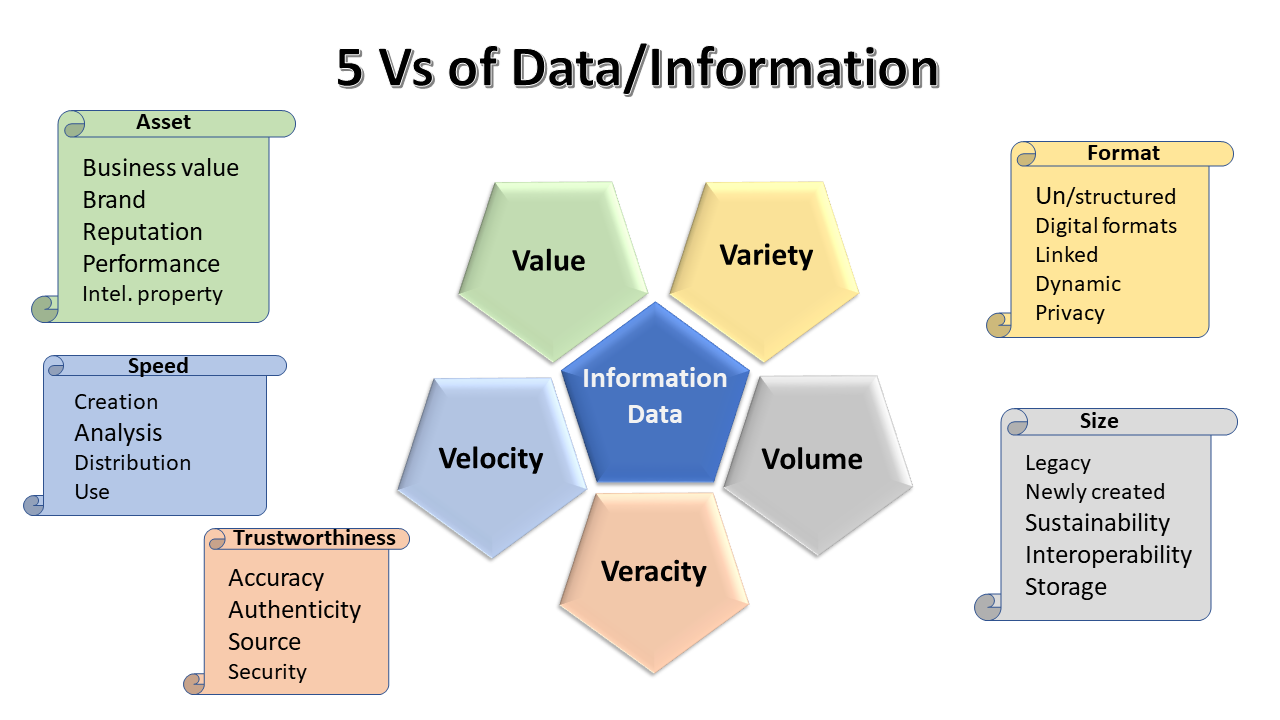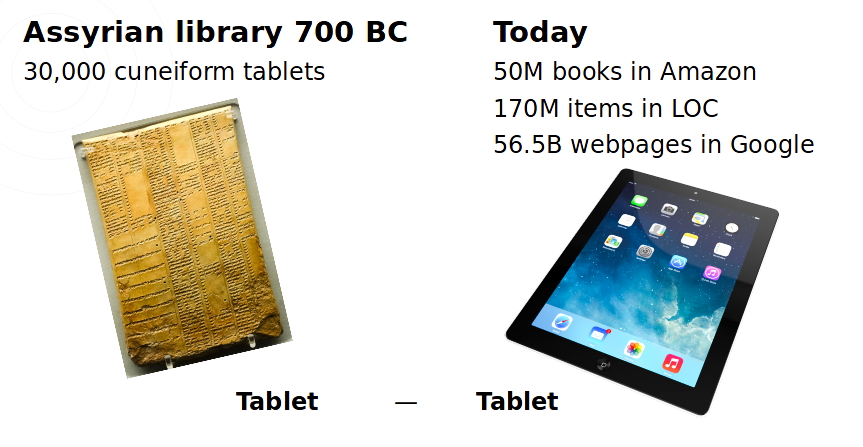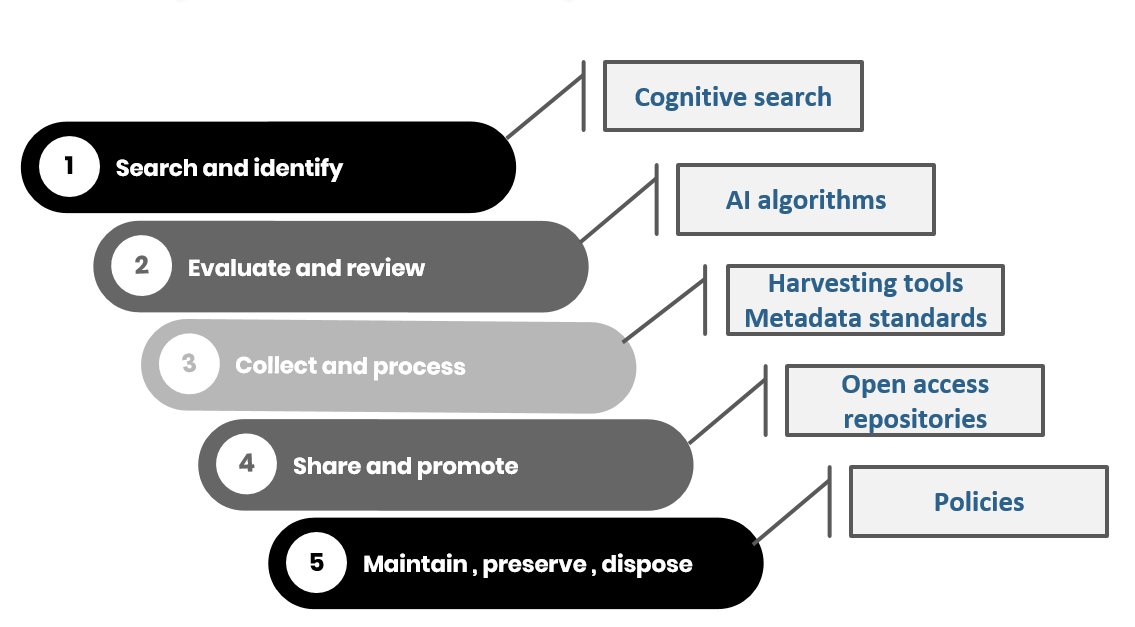A change from analog to digital is upon us. Economy and society, science and education, culture and politics, and our private and business lives are all undergoing a digital transformation. During a short period of time, we have moved from experimentation to implementation. While some of the most advanced and complex systems based on artificial intelligence, machine learning, automation, big data, and other information technology-intensive applications are also being successfully deployed.
This article looks at the impact of digital transformation (DX) on the future of library work. While looking at enablers and drivers of digital transformation, four possible impacts will be considered.
The first one is the digital transformation impact on the future of library work through the change of products and services and the creation of digital goods. The second is the impact on library processes or so-called operational agility. A very important change to be expected is regarding the relationships with customers or customer-centricity. Finally, there will be a major impact on the library workforce, so attention will also be devoted to the workforce requirements for achieving successful digital transformation of libraries.
What is digital transformation?
In order to continue, we need to define digital transformation, preferably using some simple terms, such as the following one:
Digital transformation is about doing things differently — creating a completely new business model by using modern information and computer technologies.
Digital transformation leverages existing knowledge to profoundly change the essence of the organization — its culture, management strategy, technological mix, and operational setup. It places the customer at the center of all its decisions and actions.
Enablers
Several developments enabled the appearance of digital transformation. They include:
- Dramatic increase of IT processing power
- Communication speed
- Introduction of automation and robotics
- Appearance of augmented, virtual, and mixed reality
- Artificial intelligence and machine learning
- Big data
- Strong analytics
- Powerful visualizations
Drivers
The drivers behind the push for the use of digital transformation are:
- Strong competition
- Financial pressure
- User expectations
- ‘New normal’ (a product of the COVID-19 pandemic)
We need to keep in mind that the existence and use of modern and powerful IT tools are not enough. Organizations need strong management, solid vision, and forward-looking leadership. New business models also need to be created using available IT solutions, leveraging existing knowledge and profoundly changing the essence of organizations — their culture, management strategy, technological mix, and operational setup. All this is geared towards pursuing new revenue opportunity streams, creating new products, and inventing new services.
Future scenarios
For many centuries, the library has remained almost unchanged, characterized by its physical location, collections of books and documents, types of catalogues, and library professionals helping visitors to find the right information and knowledge.
The introduction of computers has challenged almost every aspect of the classic library concept. Having an online library without a physical location, but with access to millions of electronic files, new retrieval tools, and the absence of library professionals to offer assistance are just some of the newly introduced changes.
Even a light review of future library scenarios indicates that there are very different future scenarios, predictions, and views.
Minimalists believe that libraries are already well-developed and automated, so even with a small change, libraries will meet the needs of the future. In other words, libraries will stay more or less as they are today.
Another group of researchers and futurists take a medium road, and they advocate for considerable change. According to them, the library will transform through augmentation but would remain recognizable as what we consider today as a contemporary library.
A growing group of researchers interested in the future of libraries, foresee a major change coming. They believe libraries will undergo a substantial transformation, becoming hardly recognizable, yet still regarded as ‘libraries’. In other words, they will have highly automated collections of electronic texts manipulated by sophisticated AI-based applications, offering text understanding and interpretation, aggregation of ideas, intelligent argumentation, and complex presentation of existing concepts.
Finally, a much smaller group of authors takes an extreme position and believes that there will be no libraries in the future, or at least, not libraries as we know them today. Instead, there will be intelligent machines of extreme quantum computing power containing all knowledge ever recorded, dealing with knowledge qubits, and capable of coming up with new ideas and offering creative solutions.
This does sound like science fiction, but we should not forget that even today many parts of that immense system already exist or are being developed.
Digital goods
Digital transformation already impacts all five facets of digital goods. It changes the variety of digital goods, their volume, veracity, velocity, and also their value.

The first Assyrian library in the 7th century BC, located in Nineveh in modern-day Iraq, included some 30,000 cuneiform tablets and were organized according to subject.
Today, worldwide, 2.2 million books are published annually, while the Library of Congress hosts 170 million items. Amazon, a newly created holding and selling place, holds 50 million books. Google, the biggest library ever created, has a gigantic collection of 56.5 billion web pages.

Regarding the future, we can only wonder what tomorrow’s versions of AI-powered virtual assistants will bring us. How will future versions of Amazon Alexa, Apple Siri, Google Assistant, and Baidu Duer change our world?
Operational agility
Operational agility is the ability of an organization to flex and adapt its operations, technology and information to constantly evolving business requirements brought about by digital transformation, market dynamics, competitive pressures, and business turbulence. It is regarded as the next level of business resiliency. Organizations with operations that are flexible enough to adapt to change are in better positions to maintain continuous business operations while safeguarding their people, customers, business and information flows.
To organize for agility, libraries need to identify opportunities and the threats they face, focus on interdisciplinary teamwork, plan their regular and development work, and encourage innovation.
Customer-centricity
One of the strongest characteristics of librarians has always been their strong relationships with their customers and their orientations towards the delivery of high-class customer services. The focus of digital transformation is exactly on customers, which gives a considerable advantage to library professionals in meeting the needs of the future library and a new work environment.

As we contemplate the future of libraries, a recurring theme surfaces. The sustainable future of the library and faith in the institution is not so much about information retrieval and document management, but rather providing top-notch customer service. The main requirements are high-quality communication and listening skills, patron-focused spaces, customer service practices and their personalization, customer satisfaction monitoring, and the use of proper metrics. The goal is to provide a positive experience and build long-term relationships.
Workforce competencies
The advancement of technology almost always outpaces existing workplace structures, and that is also the case with digital transformation. Lines of command, strict hierarchy, no agility, long decision-making processes, lack of flexibility, complex structures, and legacy human resource solutions are just some issues companies undergoing transformation must deal with.
The impact will be felt by information managers, as well as by the library workforce. The expectation is that the change will be multifaceted and will require the following competencies:
- Digital literacy or technical knowledge
- Full engagement
- Dealing with information and cognitive overload
- Flexibility and adaptability
- Lifelong microlearning and personal development
- Emotional intelligence and social skills
- Cultural and other diversity
- Transdisciplinary approach
- Mobile force and remote work
- Understanding of the generation gap
- High-level digital ethics
According to the recent study by the World Economic Forum, augmentation of existing jobs through technology may free up workers from the majority of data processing and information search tasks. In other words, there is a direct threat to all those jobs that are predominantly oriented towards information retrieval, search, and information delivery, such as the case with many library positions.
As the figure below illustrates, five main library functions already have considerable technological replacement using modern IT solutions, such as artificial intelligence, cognitive search, harvesting, automated full-text repositories, up-to-date standards, and modern methodologies.

Conclusion
Digital transformation will bring unprecedented changes to the world as we know it today.
The world of libraries will undergo considerable changes, but the 2700 years long history of libraries will not come to an end. Library leadership and management, tools used, and internal organization will need to become agile, while librarians need to acquire new skills, improve teamwork and cooperation, maximize creativity, and foster innovation. Libraries are here to stay, because:
“Without libraries what have we? We have no past and no future.”
Ray Bradbury
Tag/s:Business TransformationCustomer ExperienceDigital Disruption







Trackbacks/Pingbacks